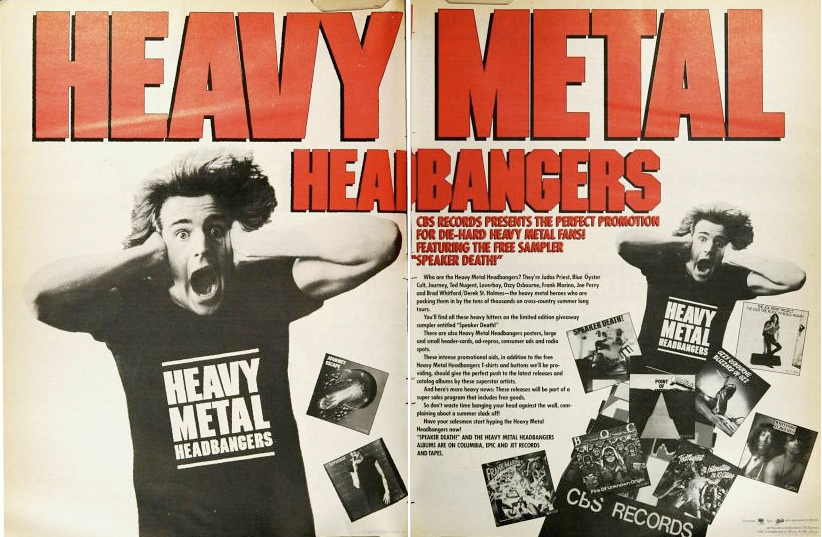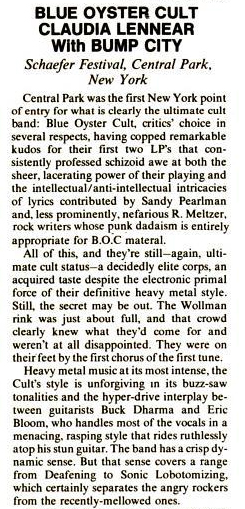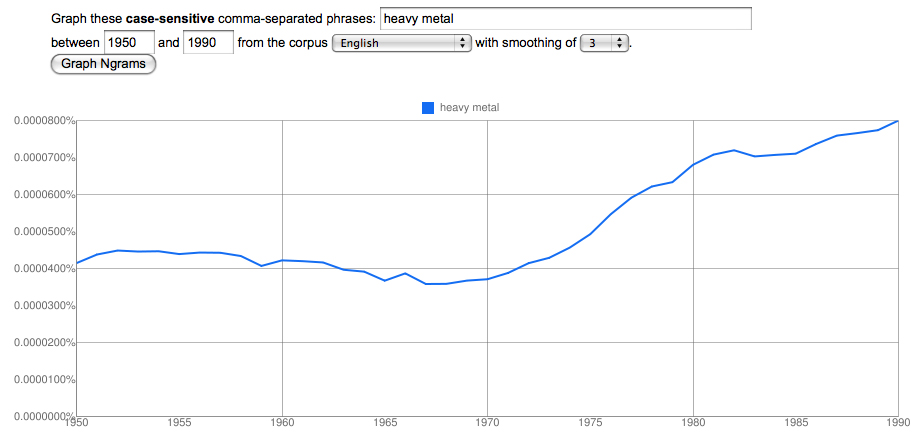Anyone who went to an American high school in the 1980s or later, when black t-shirts displaying stylized band logos were a common sight, is likely to be confused by what “heavy metal” meant in the prior decade. I’m still unsure, frankly. Today, the consensus is that in the 1970s, heavy metal was whatever Black Sabbath and Judas Priest were playing out of the gate (their first albums appeared in 1970 and 1974, respectively). However, that ignores how broadly the term was applied in this decade to bands across the spectrum of acid rock, boogie and progressive rock. Using Google, I found a 1973 concert review in Billboard Magazine of Blue Öyster Cult (mustn’t forget that umlaut!) lauds their “quintessential heavy metal style.” Who today recognizes the Cult as heavy metal pioneers?
By the late 1970s, things were further complicated by that other heavy metal that teenage guys might obsess about: the soft-porn illustrated sci-fi/fantasy magazine originating out of France. The first American issue of Heavy Metal came out in 1977; four years later, “Heavy Metal” the animated feature film became a midnight movie staple. You might expect by this point that its soundtrack would borrow liberally from the identically-named genre. You would be wrong, of course. A Dio-era Black Sabbath track (the ripping “Mob Rules”) pretty much exhausts what today we’d consider heavy metal on that double album. Okay, Sammy Hagar’s title track is pretty rocking, too, but the other title track that got bigger play came from Eagles guitarist Don Felder; needless to say, no way was that metal. And Devo? Donald Fagen? Stevie Nicks?
I’m thinking it was the “New Wave of British Heavy Metal” that established heavy metal as a musical style or genre that bands could be categorically associated with. But NWOBHM didn’t happen until the late 70s, and probably none of those bands made a dent on American popular culture before the 1980 debut album by Iron Maiden (the ultimate black t-shirt band). This argument is supported by an internet search of “heavy metal” in the Google Book archives. In the 1970s, this term almost entirely calls up geology and chemistry publications; by the 1980s, the music books and magazine articles rise to the top.
Rather than a musical style or genre, heavy metal in the 1970s seemed to refer to a musical aesthetic, even a dynamic, that a group might use on particular songs. Deep Purple and Led Zeppelin are perennially identified as two heavy metal groups, but really neither band was easily confined to the label. Just to focus on Zeppelin, the driving riffs of “Whole Lotta Love” certainly qualifies that song as proto-metal, but would you call their sock-hop slow-dance anthem “Stairway to Heaven” metal? Compare this to the case of Metallica: when they recorded their first ballad, “Fade to Black,” for their second album in 1984, no one would doubt it was a heavy metal ballad.
What was this heavy metal aesthetic of the 1970s? Wikipedia’s entry on “heavy metal” states, “In 1979, lead New York Times popular music critic John Rockwell described what he called ‘heavy-metal rock’ as ‘brutally aggressive music played mostly for minds clouded by drugs,’ and, in a different article, as ‘a crude exaggeration of rock basics that appeals to white teenagers.’” That’s pretty good; come to think of it, that’s not too bad a characterization of what the illustrated Heavy Metal magazine was striving for in its approach to sci-fi/fantasy, either. But for sheer poetry, I prefer the opening passage of Chuck Eddy’s Stairway to Hell: The 500 Best Heavy Metal Albums in the Universe:
The turbulence that calls itself “heavy metal,” or the best of it anyway, is a triumph of vulgarity, velocity, verbal directness, violent apathy, conceptual simplicity, pissed-off punkitude, adolescent overeating. Once upon a time, for years and years and years, it was the one place financially and familially and fornicatively frustrated post-pube brats (musically inclined or otherwise)could turn to vent their drunken distress or hear others approximate the same. (Misery loves company.) Best of all, metallic heaviosity had NO REDEEMING SOCIAL VALUE, and it was real loudabout it and funny too, and sometimes (once in a while) it still is.
(Chuck Eddy is, of course, no conventional music critic. With this criterion, he undertakes possibly the most idiosyncratic ranking ever in the name of heavy metal: the New York Dolls’ debut comes in at #6, [R.I.P.] Teena Marie’s Emerald City at #9 [!!!!], etc. Still, it’s seems significant that he identifies himself as “a seventies snob.”)
I’ve been thinking about what heavy metal meant in the 1970s as I re-read Will Straw’s 1984 article, “Characterizing Rock Culture: The Case of Heavy Metal.” Examining the pre-punk, pre-disco era “from 1969-70 to 1974-6,” Straw identifies important context for the teenage wasteland that Eddy rhapsodizes about:
Suburban life is incompatible for a number of reasons with regular attendance at clubs where one may hear records or live performers; its main sources of music are radio, retail chain record stores (usually in shopping centres), and occasional large concerts (most frequently in the nearest municipal stadium)… [T]his institutional network… in conjunction with suburban lifestyles, […] defined a form of involvement in rock culture, discouraging subcultural activity of the degree associated with disco or punk, for example. Heavy metal culture may be characterized in part by the absence of a strong middle stratum between the listener and the fully professional group… Observation suggests that heavy metal listeners rarely become record collectors to a significant extent, that they are not characterized by what might be called ‘secondary involvement’ in music: the hunting down of rare tracks, the reading of music-oriented magazines, the high recognition of record labels or producers. To the extent that a heavy metal ‘archive’ exists, it consists of albums from the 1970s on major labels, kept in print constantly and easily available in chain record stores.
Upon reading these claims, maybe your first impulse is to shake your head in disbelief and state the obvious: he’s wrong. I know that’s what I did. As everyone knows, heavy metal as established by NWOBHM and then the American thrash scene—think of all those black t-shirts for Metallica, Slayer, Megadeth, Anthrax, Exodus, Testament, and on and on and on—is associated with a subculture of demo cassettes, import zines, bootleg videos, independent record labels, and specialty record stores. And cities have been at the heart of this subculture: London, the Bay Area of California, New York/Long Island, and so on. This counterargument, however, adopts today’s revisionist, 80s-centric viewpoint. History may have proved Will Straw wrong (he concedes as much in the 1993 second edition of The Cultural Studies Reader that I have), but that doesn’t mean he was wrong for the 1970s. So again, I ask: What was “heavy metal” in the 1970s?
Finally, it’s worth noting the theoretical binary that Straw’s argument leaves us with: urban/subculture versus suburban/mass culture. This is a framework deserving of further scrutiny. Are cities the ideal platform for that “strong middle stratum between the listener and the fully professional group”? Are they the only such platform? And, perhaps most importantly, what role do cities play still now that the internet disembodies so much of the DIY institutional networks that musical subcultures thrive upon?







1 comment
ron naccarella says:
Apr 10, 2014
Rock and roll should not be analyzed or even thought about deeply.